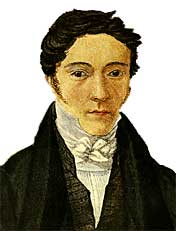Louis-Nicolas Robert
| Louis-Nicolas Robert | |
|---|---|

Louis-Nicolas Robert painted by his sister
|
|
| Born |
2 December 1761 Église Saint-Eustache, Paris |
| Died | August 8, 1828 (aged 66) Vernouillet, Eure-et-Loir |
| Occupation | Soldier, mechanical engineer, clerk, teacher |
| Known for | 1799 Patent for manufacture of continuous paper |
Louis-Nicolas Robert (2 December 1761 – 8 August 1828) was a French soldier and mechanical engineer, who is credited with a paper-making invention that became the blueprint of the Fourdrinier machine.
In 1799, Robert patented the first machine to produce 'continuous paper'. After a series of legal and financial quarrels with Saint-Léger Didot, Robert lost control of his patent. The machine was then shipped out of post-revolutionary France and further developed in England. Robert's invention became the core of the Fourdrinier machine, the basis for modern papermaking. He eventually became a school-teacher and died in penury.
Louis-Nicolas Robert was born to aging parents on rue Neuve-Saint-Eustache, 1st arrondissement of Paris. As a child he was physically frail and self-conscious, but studious and ambitious. He received an excellent education with a strong focus on science and mathematics at the hands of the religious order of the Minimes. He felt guilty for being a financial burden to his parents. At the age of 15, he tried to enlist in the army in order to support the American Revolution, but was rejected. He was accepted into the military four years later.
On 23 April 1780 he joined the First Battalion of the Grenoble Artillery, and was subsequently stationed in Calais. In 1781 he transferred to the Metz Artillery regiment and was sent to Saint-Domingue, where he fought the English. He served in the military for 14 years (circa 1794), and rose to the rank of Sergeant Major. Another account of Robert's military career suggests that he left the army aged 28, in 1790.
Robert married Charlotte Routier on 11 November 1794, in a civil ceremony. The ceremony was civil because of the post-Revolutionary decree that marriage be a simple civil contract, certified by a municipal officer.
In 1790, having finished with his military career, Robert became an indentured clerk at one of the Didot family's renowned Paris publishing houses. First working under Saint-Léger Didot as a clerk, he later switched to a position as "inspector of personnel" at Pierre-François Didot's paper-making factory in Corbeil-Essonnes. This well-respected establishment had a history dating back to 1355 and supplied paper to the Ministry of Finance for currency manufacture. Both Robert and Didot grew impatient with the quarrelling workers, vatmen, couchers, and laymen, so Robert was spurred to look for a mechanical solution to the manual labour of the paper-making process.
...
Wikipedia
